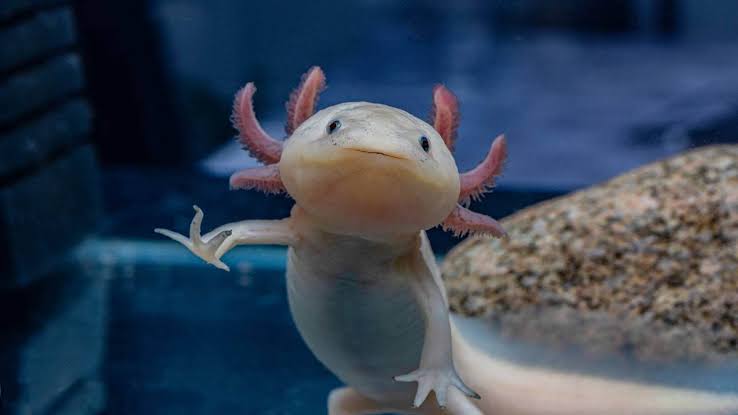
"Axolotl 101: Secrets to Keeping This Smiling Salamander Happy" – Explaining their aquatic needs, feeding habits, and tank setup.
Axolotls, often called "smiling salamanders," are fascinating aquatic creatures that require specific care to thrive. They need a well-maintained tank with cool, clean water, a proper diet rich in protein, and a stress-free environment. This guide will cover their habitat needs, feeding habits, and essential tank setup tips to ensure their happiness and longevity.
🐶 Pet Star
10 min read · 30, Jan 2025

Understanding Axolotls and Their Natural Habitat
Axolotls (Ambystoma mexicanum) are fully aquatic amphibians native to the lakes of Xochimilco and Chalco in Mexico. Unlike other salamanders, they do not transition into a terrestrial form and instead retain their larval features throughout their lifespan. Their external gills, wide smiles, and frilly appendages make them a truly unique pet.
To mimic their natural environment, an axolotl's tank should be carefully maintained to provide optimal water conditions, sufficient hiding spots, and a proper diet.
Setting Up the Perfect Tank
A well-designed tank setup is crucial for your axolotl’s health. Here’s what you need to consider:
1. Tank Size & Space
- A single axolotl requires a minimum of a 20-gallon tank to ensure adequate swimming space.
- If you plan on keeping multiple axolotls, provide at least 10 additional gallons per axolotl.
2. Water Conditions
- Temperature: Axolotls thrive in water temperatures between 60-68°F (16-20°C). Avoid temperatures above 72°F (22°C) as it can cause stress and illness.
- Filtration: A sponge filter or low-flow external filter works best since axolotls dislike strong currents.
- Water Changes: Change 20-30% of the water weekly to maintain cleanliness and prevent ammonia buildup.
- pH Levels: Maintain a pH between 6.5 and 7.5.
3. Substrate Choices
- The safest option is bare-bottom tanks or fine sand to prevent accidental ingestion.
- Avoid gravel, pebbles, or small rocks as axolotls may swallow them, leading to digestive blockages.
4. Decor & Hiding Spots
- Provide caves, PVC pipes, or plants as hiding spots to reduce stress.
- Ensure that any decorations are soft-edged to prevent injuries.
Feeding Your Axolotl: Diet & Nutrition
Axolotls are carnivorous and require a diet rich in protein to stay healthy. Their diet should consist of:
1. Live & Frozen Foods
- Earthworms (nightcrawlers are the best choice)
- Bloodworms
- Brine shrimp
- Blackworms
- Small feeder fish (only if disease-free)
2. Pellet & Processed Foods
- Axolotl-specific pellets
- High-quality sinking carnivorous fish pellets
3. Feeding Schedule
- Juvenile axolotls: Feed once daily.
- Adult axolotls (over a year old): Feed every 2-3 days.
Axolotls can be hand-fed, or food can be dropped into the tank using tweezers. Be sure to remove uneaten food to maintain clean water.
Handling & Interaction
Unlike many other pets, axolotls should not be handled frequently. Their skin is extremely sensitive, and excessive handling can lead to stress and damage to their delicate slime coat. If handling is necessary, do so with wet hands and for the shortest duration possible.
Common Health Issues & How to Prevent Them
1. Fungal Infections
- Signs: White, cotton-like patches on the skin or gills.
- Prevention: Maintain clean water conditions and avoid high temperatures.
- Treatment: Salt baths (if needed) and improved water quality.
2. Ammonia Poisoning
- Signs: Gasping at the surface, lethargy, red or irritated skin.
- Prevention: Regular water changes and proper filtration.
- Treatment: Immediate water change and checking ammonia levels.
3. Impaction (Blockage from Ingesting Objects)
- Signs: Swollen belly, lack of appetite.
- Prevention: Use only fine sand or bare-bottom tanks.
- Treatment: Fasting and offering soft foods like bloodworms.
4. Floating Issues
- Signs: Axolotl unable to sink properly.
- Causes: Air bubbles in the gut, impaction, or stress.
- Treatment: Fasting, gentle burping, or checking for substrate ingestion.
Q&A Section
Q1: Can I keep multiple axolotls together?
Ans: Yes, but they must be similar in size to prevent aggression. Also, provide ample space and hiding spots to reduce stress.
Q2: Can axolotls live with fish?
Ans: It’s risky. Small fish may be eaten, and larger fish may nip at the axolotl’s gills. If attempting tankmates, choose peaceful, non-nippy species.
Q3: Do axolotls need a heater?
Ans: No, they prefer cool water. A chiller may be needed in warm climates to keep water below 72°F.
Q4: How long do axolotls live?
Ans: With proper care, they can live 10-15 years or more.
Q5: Why is my axolotl not eating?
Ans: Check water conditions, ensure proper temperature, and try offering live food. Stress or illness may also be a factor.
Similar Articles
Find more relatable content in similar Articles

Smart Homes for Pets: Automated Feeders, Doors, and Mo..
As smart home technology advan.. Read More

Sustainable Pet Products: What to Look for in 2025...
As sustainability becomes a ce.. Read More

How Pets Strengthen Family Bonds...
Pets are more than just compan.. Read More

How Climate Change Affects Wild and Domestic Animals...
Climate change is dramatically.. Read More
Explore Other Categories
© 2024 Copyrights by rPets. All Rights Reserved.